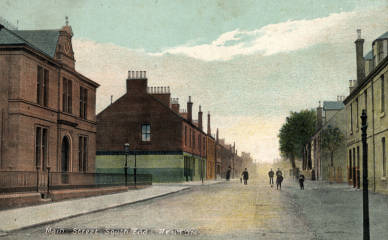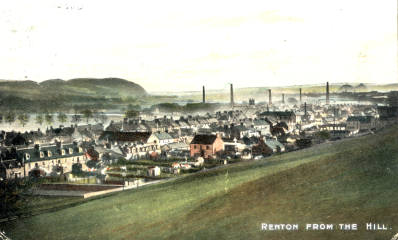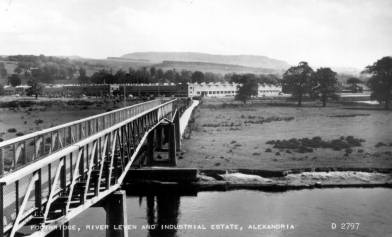RENTON A BRIEF HISTORY from 1715 to 2008 - Page 4
Page 1 | Page 2 | Page 3 | Page 5
If the loss of the football club was disappointing, the beginning of the 20th century didn't seem to bring much better luck to the village, as the town experienced a depression in the textile industry. Although nothing on the scale of what was to come, with hindsight both this down-turn and the strike in 1911 in the UTR works over pay and conditions, which turned ugly for a short time, were harbingers of things to come not just for Renton, of course, but for the industrial areas of the whole of Britain.
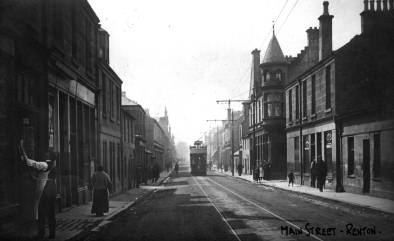
Renton Trams Click to Enlarge
However, an apparent economic recovery was made, and a bright spot in the first decade of the 20th century was the arrival of the Balloch - Dalmuir tram system through the town in 1908. It was a single line system, down the middle of Main Street, but there was a passing place outside the school. The growth in the population in the period 1850 - 1900, during which it virtually doubled from about 2,800 to a peak of over 5,000, put considerable pressure on housing and social conditions in the older part of Renton, which remained the core of the town.
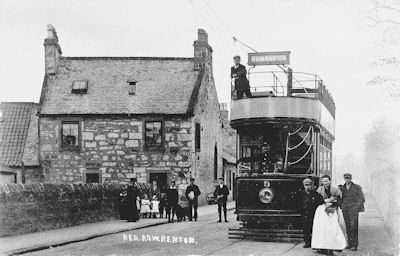
Tram at Red Row (Click to Enlarge)
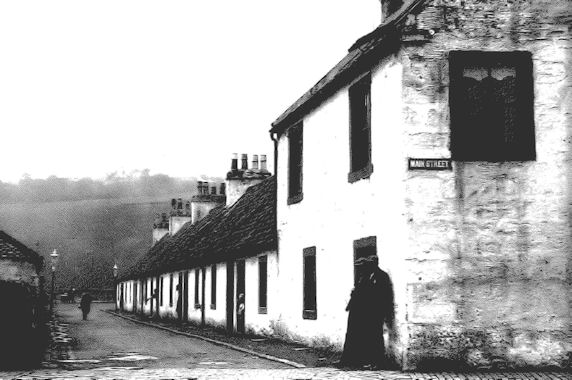
Another view of Red Row
Private landlords rented most of the housing stock to factory workers, and most of it was neither modern nor maintained to satisfactory living standards. Families living in one or two room houses in stone-built tenements were the norm, and overcrowding was therefore commonplace, with all the accompanying health and social problems. There were outbreaks of typhoid (1891) and smallpox (1901). As the First World War approached it was clear that new housing stock was urgently required, and the existing houses needed either refurbishment or demolition.
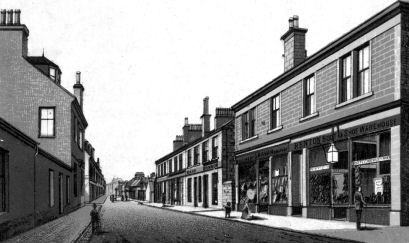
Renton Main Street (Click to Enlarge)
The outbreak of war in 1914 left the issue both unresolved and clouded by the fact that there seemed to be no clear political will nor means of tackling the problem. Instead, the community turned to “doing its bit” against the Germans who had invaded small, defenceless Belgium en route to attacking its main enemy, France. At the time, the issue seemed clear cut to the majority of the public - Britain had to help poor little Belgium against the German bully.
The response in Renton was not untypical, although it was at the high end of levels of volunteering for military service. It is reckoned that over 500 Renton men  had volunteered by 1915, which means that virtually every man of service age had volunteered (this was before conscription had been introduced). Many more went to serve in subsequent years.
had volunteered by 1915, which means that virtually every man of service age had volunteered (this was before conscription had been introduced). Many more went to serve in subsequent years.
There are two main legends about Renton's role in WW1. Firstly, that every house in Back Street lost someone in the war. That is almost certainly true. The second involves Lord Kitchener, Minister of War, who was drowned off Orkney in 1915.
Kitchener is reputed to have said during a tour of inspection either, that with more soldiers like the Rentonians he would have already finished the war, and/or, when learning that so many soldiers had come from Back Street, he expressed a wish to visit it.
There's no independent record of him actually saying either, but then again, there doesn't need to be for us to give them the benefit of the doubt, because these are the sort of things that Kitchener did say on his tours of inspection, and he certainly meant them at the time of speaking.
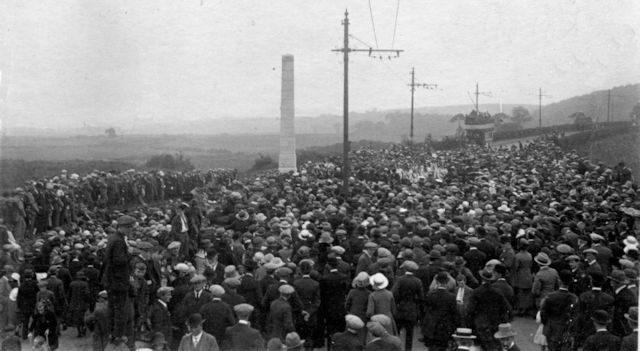
Unveiling of Renton War Memorial 1922
The war memorial, unveiled in September 1922 at the Howgate, at the south of the town, contained the names of 157 Rentonians killed in the War (it was moved to its present site in 1988 beside the Smollett 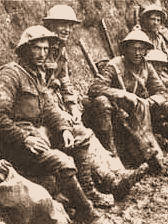 Monument at the heart of Renton, because of continuing vandalism), is the only lasting physical evidence of the contribution and sacrifice made, although the legends rightly live on. Some time after the unveiling a poem was written about the event (by James Cowan). Click here to view >
Monument at the heart of Renton, because of continuing vandalism), is the only lasting physical evidence of the contribution and sacrifice made, although the legends rightly live on. Some time after the unveiling a poem was written about the event (by James Cowan). Click here to view >
By 1919 the mood of people had mightily changed across Britain, and would never go back to the meek acceptance of things just jogging along as they always had done, with everyone meekly accepting their place in society as dictated by their “betters”.
Nowhere was this truer than in the Vale as a whole and Renton played its full part. There were a number of factors, which caused this change, both national and local - and two in particular stood out across Britain. Firstly, the massive slaughter in the trenches was not only strongly felt in every local community, it was also lasting proof of the incompetence and indifference of the ruling class. Secondly, promises that had been made during the war, of better times ahead at the war's end, in an effort to boost support for the war.
Lloyd George's promises of “a land fit for heroes to live in” and “homes for heroes” are the best known. Such was Lloyd George's prestige in 1917 –18, that these promises were believed by the soldiers and their families, and probably by 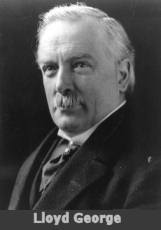 him as well. He was in a political coalition by the war's end however, the major part of which was the Conservative Party. The objectives and priorities of the Conservative leaders and their advisers were at odds with delivering on Lloyd George's promises.
him as well. He was in a political coalition by the war's end however, the major part of which was the Conservative Party. The objectives and priorities of the Conservative leaders and their advisers were at odds with delivering on Lloyd George's promises.
Their priority was to get back onto the gold standard as part of an economic policy of tight fiscal constraints for everyone except themselves. It was the exact opposite of what the economic circumstances required, and contributed greatly to the difficult 1920's and the totally disastrous 1930's. However, during the war, a report into housing conditions in Scotland had been commissioned as evidence of the government's good faith. The report was published in 1917 and was a damning indictment of the private landlords. As a result of this report, in 1919 the Housing and Town Planning (Scotland) Act was passed. This ushered in the era of council housing in Scotland by empowering central government to built social housing and using the local authorities as the means of local delivery of housing programs.
It was followed up by another six acts by 1938, and council housing estates sprang up everywhere. In the 1920's these were characterised by being two-storey, brick-built semi-detached and terraced buildings with ground around them for gardens and drying-greens. By the 1930's as money became tighter and the need more urgent, the typical council build was a three storied terraces still with garden and greens front and back.
The difference is quite visually apparent in Renton to this day - you can see at a glance from the difference in the types of houses in the estates that Hillfoot and Tontine were built in 1920's, while what remains of the original Cordale dates from the 1930's. Hillfoot was Renton's first council house scheme, being started in about 1927, with the first occupants moving in 1928. The name Hillfoot dates from that time and the development of the estate saw the demolition of the old Red Row church, Renton's oldest church (by then a metal works), and the opening up of the Red Row cul-de-sac to give access to both Back Street and Hillfoot at their junction with Red Row.
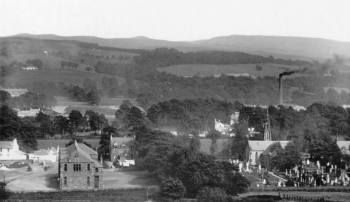
Renton North End (Click to Enlarge)
Tontine started a little later, the old Tontine Park, home of Renton FC on which the estate is built, having been acquired by the county council about 1927. The building of Tontine Park houses began in 1928, with occupancy starting in 1929. The loss to football and other sporting events of Tontine Park, had already been offset by the laying out of Wylie Park, partly on the old Public Park, but mainly on ground which was donated to the people of Renton by Alexander Wylie of Cordale House, owner of Cordale and Dalquhurn Works, a then director of the UTR after its formation in 1897.
Wylie was also the Conservative MP for Dunbartonshire from 1895 until 1906 when he retired from politics. It's a sobering thought that he was last local MP who actually lived in any of the Vale villages or towns - and that was 102 years ago.
The centre spot of the World Champions home ground was marked for many years by a plaque, but sadly that too has disappeared. The building of these estates meant the demolition of some of the worst of the slum housing, particularly around Back Street and the lanes and closes running at right angles to it. The Wylie's Cordale estate (but not Cordale Works, which even yet has not been built on) was acquired for council house building about 1930, and Cordale House was demolished in 1935.
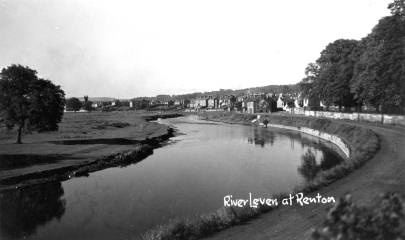
River Leven at Renton (Click to Enlarge)
The building of council houses on Cordale Estate proceeded quite slowly in the 1930's and 1940's. The first new houses were built at the southern end on Stirling Street and the scheme gradually worked north over nearly twenty years to the Mill Burn at Turnbull's Loan. The first buildings were of the three-storied type, 6 in a block tenement style with front gardens and back greens. They were located in a sort of “L” shape from Main Street down Stirling Street. Occupancy began in 1932.
By 1937, Cordale was being substantially extended along the riverfront and gradually expanding into the rest of the former Wylie estate. Cordale Avenue, Crescent and Road date from this time onwards. Cordale Road's nickname of “The Burma Road”, named after the tortuous supply line built through the Himalayas from northern Burma to the Chinese armies fighting the Japanese, places its completion in the war years, as well as indicating the frustration of Rantonians at the slowness at its completion.
Some of the tenements in Main Street were not built until after the war, and about the same time 12 or so prefabs were built on the site of the old Cordale House. All of this council house building from the 1920's to the 1940's ran far short of Renton's requirements. However, the national and local economies were in a sorry state from the early 1920's onwards with only a modest respite in the mid 1920's, before the disasters of the 1930's. In Renton, Cordale Works never really got going again after the First World War, and neither did the nearby Dillichip Works at Bonhill, nor Milton Works at Jamestown. Ferryfield in Alexandria actually closed during the War, in 1915.
Also, there was now no call for the munitions produced at the Argyll Works in Alexandria by Armstrong Whitworth, who laid off the entire 2,000 people workforce in 1919. The yards on Clydeside, which had expected to be busy, replacing ships lost in the war, were in fact subject to rationalisation to reduce capacity. So unemployed Rentonians had no other jobs to turn to nearby.
The early 1920's were hard in Renton, with about 20% of the workforce unemployed - and that excludes those who left the area to find work. The Parish Council was supposed to be the source of so-called poor-relief, or unemployment benefit. In truth, the level of demand overwhelmed the Parish Councils, and people were becoming desperate in their poverty. Many of the social patterns for which Renton became a by-word started at this time - the trips over the Kipperoch to Havoc, the summer stays at Ardmore where whole blocks of tenements set up camp together with allocated responsibilities in communal living, and the development of well-honed poaching skills.
Its hard to believe now that landowners were so concerned about the rabbits on their land, but game-keepers - of which there were about a dozen between the Kipperoch and the Black Hill road, on both sides of Carman Hill, were under instruction to drive off the poachers who wanted the rabbits to feed their families. For years, a game of cat-and-mouse was played out each night with the poachers and their nets pitting their wits against gamekeepers and the police.
Willie “Bunger” Lamont, later a Communist Councillor in Renton, first made a name for himself by allowing himself to be arrested one night while his poaching colleagues slipped away in the darkness, and then being able to prove in court that his arrest was illegal because the land on which he had been arrested was owned by someone who had no objection to people catching rabbits. He was never bothered again, and in fact the poachers whose needs were in a very different league from the landowners, usually won out.
Poaching salmon in the Leven became quite a separate issue over the years, but to begin with it, too, was a question of “one for the pot”. However, as is often the case in difficult times “cometh the hour, cometh the man.” It was at this point in the early 1920's that a new generation emerged in the Vale and Renton of politically active people who were to dominate local government in the area until the late 1940's. Renton was still in Cardross Parish Council territory at this stage, and that was a more conservative entity than the Vale.
In 1921 Bonhill Parish Council took a sharp turn to the left led by the redoubtable Rantonian, Dan O'Hare, who represented a Bonhill ward. The left was well represented on the new Dunbarton County Council from the 1920's onwards, and the political climate lent itself to slum clearance and new house building, albeit on a modest scale, of which the new Renton estates described above, were typical. Elsewhere in the Vale similar estates were built at the same time as Hillfoot and Tontine - Burnbrae in Alexandria and Burn and George Street in Bonhill.
In 1929, another round of local government re-organisation saw the formation of District Councils to replace the obsolete Parish councils, and handle local affairs such as lighting, sanitation and recreation. Reality was recognised, and Renton was included in the new Vale of Leven District Council, the first time it had been included with the other Vale towns and villages in the management of local affairs. Its elected councillors were now in political sympathy with their other colleagues on the council, who were predominantly on the left - Communist, Labour or Independent labour Party (ILP).
From 1929 until local government re-organisation in 1974, Renton was divided into two wards, East and West, with the boundary between the two being the Main Street. In total 4 councillors were elected - 2 in each ward, 1 to the County Council and the other to the District Council. For most of these 46 years, Renton  elected 2 Labour councillors and 2 Communist councillors, choosing people who put Renton's needs first. And these needs became extensive. By the time of the 1929 economic crash, Renton was pretty well reliant on Dalquhurn for work.
elected 2 Labour councillors and 2 Communist councillors, choosing people who put Renton's needs first. And these needs became extensive. By the time of the 1929 economic crash, Renton was pretty well reliant on Dalquhurn for work.
With the economic downturn, in 1931, the National Government of Ramsay Macdonald imposed a 10% wage reduction for everyone. The Scottish textile companies decided to break a national agreement and impose further cuts. The UTR's employees voted to take action, and about half of their 3,000 workforce came out on strike. The strike very much centred on Dalquhurn and there were violent incidents between strikebreakers and demonstrators, with many arrests taking place. The strike lasted for a number of weeks, and was eventually settled on the company's terms.
The major problem of the 1930's, however, remained unemployment with levels of unemployment in Renton sometimes over 50%, and of course that excluded the thousands who left the area to seek work elsewhere in the UK and abroad. It was little wonder that during the 1930's Renton was one of the main centres of the National Unemployed Workers Movement (NUWM).
As the Second World War approached, the Clydeside yards became busier, and the build up of munitions production and war facilities such as bases in the Gareloch and elsewhere on the Clyde, eased the pressure on unemployment. Volunteering was not the option it had been in 1914, because conscription was introduced from the outset. No bombs actually fell on Renton, although there were anti-aircraft emplacements on the surrounding hills, which came into action during raids on the Clyde, particularly during the Clydebank blitz of March 1941. It was a close call though, because Cardross was bombed in May 1941, as the shell of the bombed church still bears witness, and over 60 homes were destroyed or damaged.
Bombs landed on Carman, attracted by decoy fires lit there, and a landmine landed in one of McLaughlin's fields. A joke circulated that as soon as the landmine exploded, Renton sued for a separate peace. However, Rentonians again made their ultimate contribution with another 56 names being added to the 157 already on the War Memorial, when the updated War Memorial was unveiled in November 1949. The figure was much lower than in the First World War, reflecting the much lower casualties overall, but was still much higher than the national average.
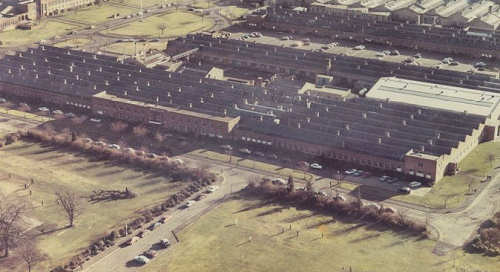
There was no repeat of the economic mistakes made after World War One, and Renton was a major beneficiary of this. A new industrial estate, funded with government money and attracting new types of light industries opened at the new Strathleven industrial estate with first production starting at Christmas 1946. By 1950 about 2,000 well-paid jobs were available at factories such as Westclox, Wiseman's and Burroughs Adding Machines. Since the target had been to create 2,000 jobs by 1956, Strathleven was rightly seen as a great success. At its peak there were about 4,000 jobs on the Estate.
A new footbridge was erected over the Leven to give Rantonians easy access to their new work place - it also gave other people working on the estate easy access to Renton shops, pubs and railway station. And in the late 1940's and early 1950's, Renton had a wealth of shops, mainly on the Main Street, selling everything from food to fashions. It is reckoned that there were about 80 shops in Renton at this time, including 9 owned by the Vale Co-op. There were also 6 public houses.
Page 1 | Page 2 | Page 3 | Page 5

